Welcome to the next iteration of Dragon Age lore dissections. Previously, I talked about Darkspawn and dwarves. This time, I will shine a light on the enigmatic Qunari people. As always, let’s start with what we know, or mostly know.
What we know
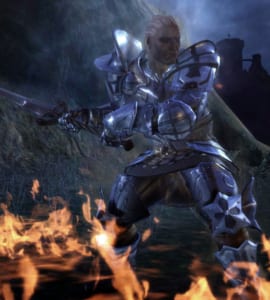
The Qunari people appear in the very first game, when Sten joins the Grey Warden’s party – that is, if we choose to let him. Sten is a perfect Qunari soldier in every way. He obeys the Qun in all things and follows orders. Everything outside the Qun is by definition imperfect, except inasmuch as it can be made to serve the Qun.
Unlike what a player might expect from such a character, Sten is very reticient about his people and their ways. When asked, he bluntly says that it’s not his job to educate the Warden. Qunari don’t believe in preaching at the best of times, and teaching is not a soldier’s task. We do learn a thing or two from him, though, and more comes in later material.
The Qun, from which the people take their name, is a philosopy that dictates the life of the entire society. Its core tenet is the natural order of the world, where everything and everyone has a proper place. “Asit tal-eb”, “it is to be”. Existence in harmony with this natural order is a choice. An individual that refuses to accept their place is only going to cause suffering to themselves, and the world around him. They choose not to be, according to the Qun.
Pursuant to that, the Qunari society has very rigid roles, which everyone receives from priestesses called Tamassrans at a young age. This branch of their priesthood controls breeding, judges the children’s potential and assigns roles. The role is a Qunari’s life, and even their name – Sten is actually the Sten, since it’s simply his rank in the Antaam, the Qunari army. Individual identity has no place under the Qun.
It also means that Sten’s unwillingness to teach the Warden came in large part from simply not knowing enough to do that. Every individual under the Qun knows just enough to play their part; the Qun as a whole is only studied by the priesthood.
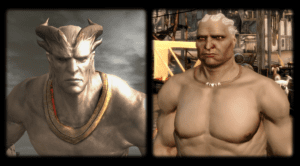 Also, just to address the elephant in the room… Sten, and the few other Qunari we see in Origins, do not have horns. BioWare stated that the intent was for them to have horns from the start, but they wanted Sten to be able to wear helmets. Which I can believe, given that ogres (Darkspawn whose broodmothers were Qunari before their capture and mutation) have horns. The explanation for his hornless head is that sometimes, a Qunari is born without them. This is taken to mean they’re meant for great things. I’d rather they’d just retconned it all the way into giving Sten horns, but that’s just me.
Also, just to address the elephant in the room… Sten, and the few other Qunari we see in Origins, do not have horns. BioWare stated that the intent was for them to have horns from the start, but they wanted Sten to be able to wear helmets. Which I can believe, given that ogres (Darkspawn whose broodmothers were Qunari before their capture and mutation) have horns. The explanation for his hornless head is that sometimes, a Qunari is born without them. This is taken to mean they’re meant for great things. I’d rather they’d just retconned it all the way into giving Sten horns, but that’s just me.
The strict segregation of Qunari society extends into gender roles. According to the Qun, each gender has roles it is simply better at, and so receives them exclusively, as it were. We don’t know the excact breakdown, but we do know that men are soldiers, while women are farmers, administrators and priests. In Inquisition, we learn about the concept of “Aqun-Athlok”, which means living as a different gender than the one you were born to. Thus, someone assigned the female gender at birth could still become a warrior – and thus be treated as a man, for all intents and purposes. It’s not clear how often this happens.
I should note that Sten doesn’t mention it in Origins, even though he expresses disapproval of women who fight. The most likely explanation is that the writers hadn’t come up with this particular facet of the Qunari society yet, at that point. Particularly since we do see Qunari women fight in Inquisition. They’re agents, spies, and assassins, but then, so is Leliana. To be fair, the Warden (if she’s a woman) and their female companions still carry themselves and identify as women, so the concept of Aqun-Athlok might not apply.
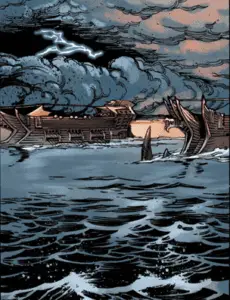 The Qunari spread their vision of the world very militantly. Their introduction to the series is that of a relentless army of steel-clad warriors who landed on the northern shores of Thedas and began a systematic conquest. In addition to their powerful stature and skill, they also have more advanced technology than any human nation – notably, gunpowder. The Qunari call it gaatlok, and it breaks the setting’s otherwise implacable medieval stasis.
The Qunari spread their vision of the world very militantly. Their introduction to the series is that of a relentless army of steel-clad warriors who landed on the northern shores of Thedas and began a systematic conquest. In addition to their powerful stature and skill, they also have more advanced technology than any human nation – notably, gunpowder. The Qunari call it gaatlok, and it breaks the setting’s otherwise implacable medieval stasis.
I should note, here, that the “steel-clad” part seems to go away in later games. There, Qunari wear little to no armour. Instead, they use tattoos they cal Vitaar. They’re magical, and harden the skin without encumbering the wearer like armour does. They seem to require Qunari physiology to function.
Tevinter Imperium fell under the invaders, but eventually, the combined efforts of different human nations repelled them. They remained in the island nations of Seheron and Par Vollen. It was clear that they considered the armistice to be a temporary one. They continued to clash with Tevinter, and in the Trespasser DLC for Inquisition, they strike directly at the leaders of other human nations.
During the wars, the southerners’ greatest advantage turned out to be magic. The Qunari hate and fear magic with a passion that makes Templars look like Harry Potter fans. They call them saarebas, literally “dangerous things”. The loss of control that a mage risks, both due to their power and potential possession, appals them. “As does a drowning man know the sea, so does a mage know magic”, they say. Mages are collared and chained, and must stay with their handlers at all times. The Qunari are ever pragmatic, though, so they do use magic when they have to.
Not that non-mages can’t get the lash under the Qun. The inner workings of its society aren’t pretty. In many ways, it’s quite totalitarian – you’re fine as long as you toe the line, but falling out of step has brutal repercussions. Those who do can find themselves in the hands of Ben-Hassrath “reeducators”. Ben-Hassrath are the Qunari secret police and spies, and the reeducators return stray Qunari to the fold. What we can read about their methods includes realistic brainwashing and psychological torture techniques, in order to systematically dismantle a victim’s identity and “reprogram” them from scratch. But they also use magical substances to brainwash them.
So, that’s the general status of the Qunari as we see it in the games. Now I’ll venture into the less clear parts of their lore, as well as my speculation on it.
What I take from it
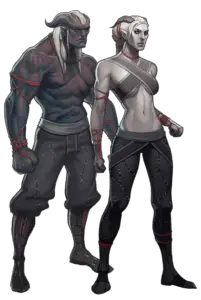 First off, the name “Qunari” does not, technically speaking, apply to the horned, grey-skinned race. A Qunari is an individual under the teachings of the Qun. Thus, a human, elf, or dwarf who follows it is also a Qunari. According to Sten, members of the other species also receive a place under the Qun, according to their capabilities. We’ve only seen them in relatively low positions, though. The Qun seems to attract a fair number of elves, who see it as a way out from under the humans’ boot.
First off, the name “Qunari” does not, technically speaking, apply to the horned, grey-skinned race. A Qunari is an individual under the teachings of the Qun. Thus, a human, elf, or dwarf who follows it is also a Qunari. According to Sten, members of the other species also receive a place under the Qun, according to their capabilities. We’ve only seen them in relatively low positions, though. The Qun seems to attract a fair number of elves, who see it as a way out from under the humans’ boot.
Nevertheless, when people say “Qunari”, they mean the grey-skinned horned giants, most of the time. The confusion over the various names for the race was addressed in a forum thread by David Gaider. There, he mentions the Kossith. For some time, I and others considered that to be the old name for the species, before they adopted the Qun. But evidently, it is not as simple as that. We don’t know if the Kossith were or are a race, culture, or group of such.
The first time we hear about the Kossith in a game, as opposed to other materials, is during dialogue with Iron Bull in Inquisition. He’s reluctant to talk about them, and doesn’t seem to know much in any event. But he also says that the Kossith are not simply who Qunari used to be. He also implies that as the Qunari left their mysterious homelands and sailed for Thedas, the Kossith remained behind. He wonders if the enigmatic Kossith weren’t the reason the Qunari left. And that’s about all we have.
Members of the species outside the Qun are called Tal-Vashoth, or just Vashoth. It means “true grey”, while Vashoth is simply “grey”. The former term refers to Qunari who abandon their ways, while the latter applies to those who never knew it in the first place, having grown up with Tal-Vashoth parents. The Inquisitor can be one such person. Again, a human, elven, or dwarven Qunari who abandons the culture is also technically Tal-Vashoth. But like with the name “Qunari” itself, most people don’t call them that.
Sten, Iron Bull, and other Qunari refer to Tal-Vashoth as brutal, barbaric killers with no remorse and no soul. The existence of Tal-Vashoth who are perfectly reasonable people contradicts it – for example, the Inquisitor (potentially), or their family. Then there’s Maraas from Dragon Age 2. Granted, he rejects Tal-Vashoth just like he did Qunari, but still. Iron Bull dismisses such cases as “exceptions”, which… is not very sound logic.
Even so, many, or even most, Tal-Vashoth do turn to banditry, abandon all pretence of morality and perform acts of cruelty. Sten calls them “devils of Seheron”, and they do earn that nickname. Sten himself bears the same of falling to all-consuming, murderous rage. He arrived in Ferelden to investigate the Blight, and his squad fell prey to Darkspawn. He himself survived, thanks to the help of some locals. However, when they told him they hadn’t seen his sword, he panicked and killed them all.
Is there some sort of inherent rage to the Qunari people, that they keep in control with the strict teachings of the Qun? It’s difficult to say. It seems to be a question of nature versus nurture. If Qunari are taught from birth that they are nothing and less than animals outside the Qun… then they know nothing else if they do choose to leave it. Or if they face the prospect of becoming an outcast, as would surely happen to a soldier who lost his weapon. Maraas even condemns his fellow Tal-Vashoth for accepting the role the Qun would assign them after they left it.
In addition, the Qun has every interest in painting its outcastes as monsters, so we face a severe lack of reliable sources on this issue. Solas also accuses the Qunari of being brutes who hold 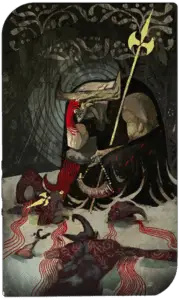 themselves in check with their mindless dogma… but Solas is not a reliable source on this subject either.
themselves in check with their mindless dogma… but Solas is not a reliable source on this subject either.
Should Iron Bull become Tal-Vashoth himself during the course of the game, it places him in a very nasty moral dilemma. If everything his teachers told him about the Tal-Vashoth is true, he’ll become a raging monster. If it’s not… then all the Tal-Vashoth he killed as a Ben-Hassrath agent were, in act, simply people who had made a choice, like him.
The reason I started considering an innate tendency to lose control is the seeming connection between the Qunari and dragons. It seems to be the largest mystery of their lore. We see nothing of it in Origins, or (as far as I know) Dragon Age 2. The first hints start in Inquisition, when it manages to actually give some background to people who aren’t elves. There also seem to be some hints in some comic books.
The main source of information about this is Iron Bull. Dragons fascinate him, and he’s absolutely exuberant if you choose to bring him along to fight one. Should you do that, he invites the Inquisitor to a celebration of the dragon-slaying. Amidts all the drinking, boasting and sexual comments, he drops some very interesting bits of knowledge.
According to him, Qunari call dragons “Ataashi”, “glorious ones”. They hardly worship them, though. They admire the dragons’ raw power and rage, but they see them as chaos that they need to tame. They’re raw, primordial forces of nature that have to be put down in order for civilization to flourish.
Iron Bull does, in fact, directly suggest that Qunari may come from dragons. His theory is that the Tamassran have mixed dragon blood into their bodies, as part of a breeding program. I don’t think it’s that simple.
If the Inquisitor is a warrior, and is considering the Reaver specialization, Cassandra warns them of possible consequences. She says that many members of her family, Penteghasts, partook in dragon blood themselves. All of them succumbed to madness… and experienced physical changes as well.
Iron Bull has the Reaver specialization, even though he never drank a dragon’s blood. Even accounting for segregation between gameplay and story (Cassandra uses the Templar specialization despite being a Seeker), it has some implications. Are Qunari an experiment in using dragon blood that proved actually stable? Qunari are tall and strong, and possess remarkable resistance to many toxins, such as those that make up Vitaar.
Some hints that it might be the case present themselves in Kieran and Corypheus. The ancient Magister, in the final battle against a Qunari Inquisitor, claims they’re not a race, but a mistake. Kieran, if he exists and carries an Old God soul in him, will say that their blood “doesn’t belong”. He also says he’s sad about what happened to the Inquisitor’s people. So… what did happen to them?
The Qunari seem to have some skeletons in their closet. Or they are a skeleton in someone else’s closet. Why could Corypheus call them a mistake if he didn’t know something about them? And whose mistake is it? Did Tevinters create them, somehow? It would be very ironic, given how they’re now barely holding on against a continuous Qunari onslaught. And ancient Tevinters did worship dragons. Then there’s the fact that Qunari mages are supposedly more powerful than human or elven ones, according to an ex-Templar working for them. And if there’s one thing the Magisters have always wanted, it’s more magic power.
Where do Kossith come in? We don’t know who they are, or were. Maybe it was the name of the people before dragon blood was introduced to them. If Qunari are dragon-blooded individuals who are stable enough to avoid most side-effects, perhaps the Kossith succumbed to the blood. Which is why the Qunari left. We have little else to go on, as our knowledge of lands beyond Thedas is so sparse.
In the Those who Speak comic books, we see Sten once more – but now he’s the Arishok, leader of the Qunari military. He replaced the one Hawke killed in Dragon Age 2. It’s possible that Hawke did no such thing, of course, but the comics follow their own canon out of necessity. When warning Alistair about Tevinter dragon cultists, he brings up what the Tome of Koslun have to say about the Old Gods. He says that they were to dragons what the first kings of men were to them. The implications of that I will leave for another article, but the fact that the sacred tome of the Qun mentions dragons says a lot.
We know that a new Dragon Age game is coming, and it’s quite likely it will take us to the north and Tevinter. If so, we might learn more about the Qunari as well, seeing how they’re Tevinter’s mortal enemy, and that the ending to Trespasser had them mobilizing for war. Perhaps we will get some answers for the questions this article poses.

